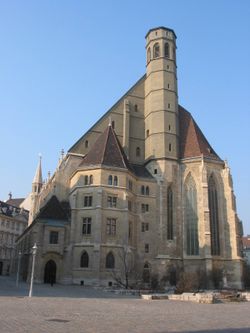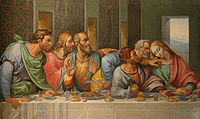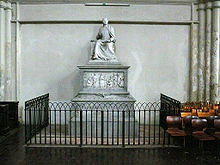- Minoritenkirche, Vienna
-
Italian National Church of Mary of the Snows 
Minoritenkirche
Basic information Location Vienna, Austria Geographic coordinates 48°12′33.9″N 16°21′49″E / 48.209417°N 16.36361°E Affiliation Roman Catholic Leadership P. Silvestru Borsa OFMConv[1] Website Official Website Architectural description Architect(s) Jacobus Parisiensis Architectural type Church[1] Architectural style Gothic Completed 1350 Specifications Length 45 m Width 35 m Width (nave) 15m Height (max) 54 m The Minoritenkirche, formal name: Italienische Nationalkirche Maria Schnee (English: Greyfriars Church or Minorite Church, formal "Italian National Church of Mary of the Snows") is a church built in French Gothic style in the Altstadt or First District of Vienna,[2] Austria.
The site on which the church is built was given to followers of Francis of Assisi in 1224. The foundation stone was laid by Premysl Ottokar II in 1276. Duke Albrecht II later supported the building process, especially the main portal. The Gothic Ludwig choir was built between 1316 and 1328, and used as a mausoleum in the 14th and 15th centuries. Construction of the church was completed in 1350.
The top of its belltower was damaged during the first Austro-Turkish war, rebuilt, then again destroyed again during the second Austro-Turkish war; the top was then replaced by a flat roof.
When Joseph II gave the church to the Italians as a present, they transferred the name Maria Schnee ("Mary of the Snows") from a nearby chapel which was subsequently destroyed.
Contents
History
The Minoritenkirche stands in the Innere Stadt of Vienna, northwest of the Hofburg, at the Minoritenplatz. The Minoriten were Franciscan monks (Latin: "fratres minores").[2] They were appointed in 1224 to Vienna.[2]
After the city fire of 1275, the foundation-stone for the new church was placed by Ottokar Přemysl.[2] It was one of the first Gothic churches in the east-Austrian area. After Ottokar's death in the battle on the Marchfeld, he was laid out here thirty weeks.[2]
A crucial break came in 1782, when the Minorite church was closed in the course of the religious politics of Joseph II.[2] The church thereupon was renamed the "Italian National Church of Mary of the Snow" (Santa Maria Maggiore) – this name exists today still. In the course, the Minoriten brought the cross to its provided with a Christ picture also over the high altar, after evacuation to Wimpassing, so that, when it came some decades later back to Vienna, it was called the "Wimpassinger cross." A copy of it hangs today in the Stephansdom cathedral.
Exterior
The whole building follows the pattern of French Cathedral architecture. The building masters are unknown; however, it is commonly attributed to Jacobus Parisiensis, Fra Giacomo of Paris , who was confessor Duke Albrecht II.[2] The portal follows a French pattern, rare for Austria.[2] The Tympanum is divided by circle impacts into three fields, whereby in the middle field, Christ on a branch cross is displayed. On the left, is Mary with Mary Magdalene and other female figures; on the right, John the Evangelist, Saint Longinus the soldier, and other male figures. The outermost male and female figures could represent Duke Albrecht II and his wife Johanna of Pfirt, particularly since the male figure seems to wear a Duke hat. The figures are very elegant and fine-linked represented: probably a French influence, and, at the same time, an important style characteristic of the Minoritenwerkstatt, which date back until approximately 1360.[2]
In the course of the new dedication also numerous changes were made by Johann Ferdinand Hetzendorf von Hohenberg, which were aimed at particularly on the removal of baroque on the inside. Nevertheless, it was not in the final result "Regotisierung," as this was called more frequently, since also parts of the gothical building of the Church were eliminated, in particular, the Ludwig choir.
In the following centuries, the church remained to a large extent unchanged, only that in different wars, the tower suffered damage several times.[2] Around 1900, the last major changes took place, in particular, the construction of the choir-like sacrament's Sakramentshäuschens. In the course of the building of underground subways, into the late 1980s, the foundation walls of the Ludwig chapel were found, which are after-drawn at the place now.
Interior
There were important changes under the first Habsburgs.[2] Blanche of Valois, the wife Rudolf III, left a chapel for her grandfather, Ludwig of France (Heiligen Ludwig von Frankreich) to the Nordweiste, which was completed in 1328.[2] It had a separate entrance and no connection to the nave. This was changed circa 1340, combined as the Ludwig chapel with the nave to a church hall with two choirs. Into the nave, new columns were added, and a new portal were constructed in the west.[2]
The Chapel of Sf Anthony of Padua holds a Baroque altar made of polychrome marble and a glass window of the 17th century.
The walls covered with frescoes of the coats of arms of Austrian aristocratic families who either contributed to the construction of the Church or are buried here.
High Altar
The Neo-Gothic high altar was made by Ferdinand Hohenberg. The altarpiece shows the Madonna della Neve (Our Lady of the Snow) revered in the Church of S. Maria Maggiore in Rome (copy by Christoph Unterberger). It is surrounded to the left by the statues of Ottokar of Bohemia and St. John the Baptist and to the right, by the statues of St. John the Evangelist and Leopold the Glorious.[3]
Mosaic of The Last Supper
There is a life-sized copy of Leonardo da Vinci's The Last Supper on the church's northern wall. It is a mosaic made by the Roman mosaic artist Giacomo Raffaelli, commissioned by Napoleon I in 1809, but it was not finished before Napoleon's abdication. Francis II of Austria bought it, wanting to install it in the Belvedere in Vienna. As it was too large for the building, it was set up on the north wall of the church, where it remains to this day. The mosaic is 9.18 x 4.47 m and weight approximatively 20 tons.[3]
Monument for Pietro Metastasio
This monument, made by Lucardi, was erected in memory of the "Poet Laureate" Metastasio in 1855. In the central relief, Pope Pius VI is depicted blessing the dying Poet. Behind him the composer Salieri followed by W.A. Mozart, while J. Haydn is looking at the Pope.
Madonna of Rossellino
This Madonna was executed by the Italian artist Antonio Gamberelli, nicknamed Antonio Rossellino, in Carrara marble (15th century).[3]
Paintings
- The glorification of St. John Nepomuck, by Bartolomeo Altomonte
- The foundation of abbey Klosteneuburg, by Martino Altomonte
- Delicate figure of St Francis of Assisi, painted by an unknown Master of the 16th century.
- The Holy Family by Hautzinger
- The Tragedy of the Plague, by Steiner
- St. Benedict and the Miracle of St Nicholas, by Daniel Gran
Trivia
- The Church is the subject of Adolf Hitler's most renowned work of art, a watercolor painted in 1910. The painting is mentioned several times in the novel Deadeye Dick by Kurt Vonnegut.
Notes
- ^ a b "Pfarre Unsere Liebe Frau zu den Schotten" (in German). Erzdiözese Wien. http://stephanscom.at/pfarren/dekanate/Stadtdekanat_1/Unsere_Liebe_Frau_zu_den_Schotten. Retrieved 11 December 2007.
- ^ a b c d e f g h i j k l m "Wiener Minoritenkirche" ("Viennese Minorite Church"), German Wikipedia, 2006-08-30, De.Wikipedia.org webpage: DWP-Wiener-Minoritenkirche.
- ^ a b c Guide of the Minoritenkirche available in the church.
Coordinates: 48°12′33.9″N 16°21′49″E / 48.209417°N 16.36361°E
External links
- Viennas Minoritenkirche see here a video of the church
Categories:- 1350s architecture
- Gothic architecture in Austria
- Roman Catholic churches in Vicariate of Vienna-City
Wikimedia Foundation. 2010.


